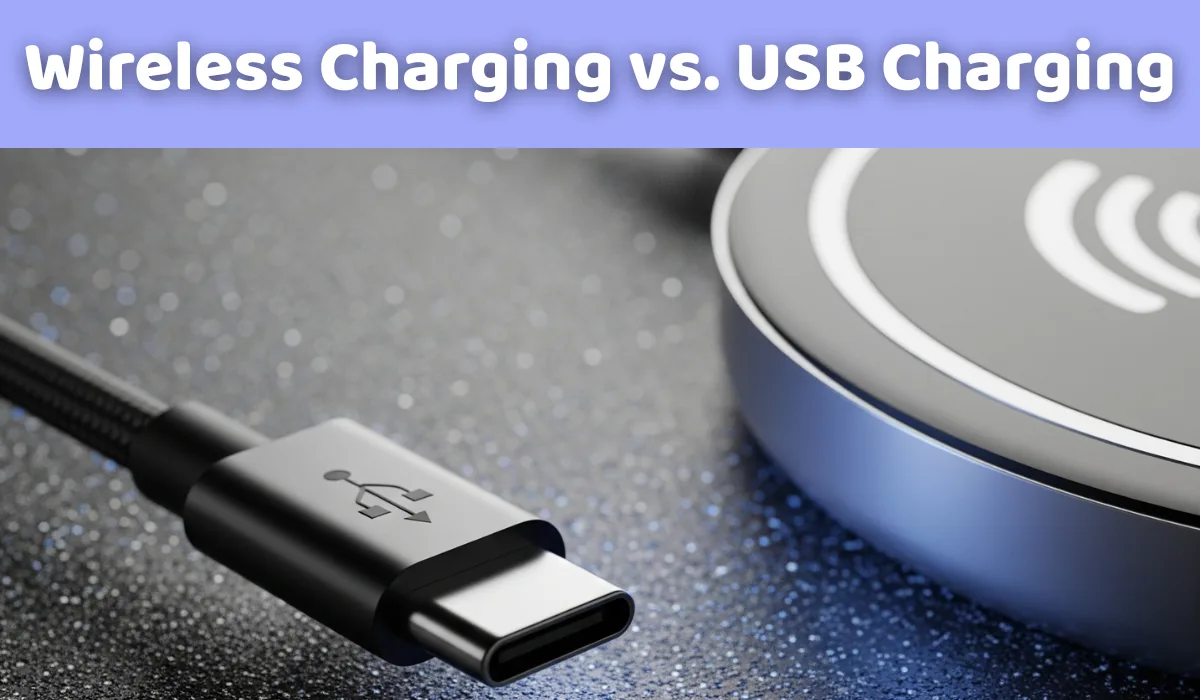Explore the key differences between wireless charging vs USB charging. Learn about charging speeds, safety, and efficiency to make an informed decision for your
🔋 Wireless Charging vs USB Charging: Which One Should You Choose?
In today’s world of fast-evolving technology, the debate over wireless charging vs USB charging is heating up. While USB charging has been the standard for years, wireless charging is gaining popularity for its convenience and sleek design. But which one is better for your devices?
Let’s explore the pros and cons of wireless charging vs USB charging, so you can make an informed decision and keep your gadgets powered up efficiently.
🔍 Understanding Wireless Charging vs USB Charging
What is USB Charging?
USB charging is the traditional method of powering devices through a physical connection via USB cables. It uses standard connectors like USB-A, USB-C, or Lightning to transfer both power and data.
What is Wireless Charging?
Wireless charging uses electromagnetic fields to transfer power without physical connectors. It relies on the Qi standard, where a charging pad and compatible device exchange energy wirelessly.
⚡ Wireless Charging vs USB Charging: Pros and Cons
✅ Pros of USB Charging
- Faster charging speeds (especially with USB-C PD or Quick Charge 4.0+)
- Stable and reliable connection
- Data transfer capability
- Lower energy loss during charging
- Wide compatibility with older devices
❌ Cons of USB Charging
- Cable clutter and wear over time
- Port damage risk (e.g., bent USB ports)
- Limited mobility during charging
✅ Pros of Wireless Charging
- Cable-free convenience: Just place your device on the pad.
- Less wear on device ports: No need to plug/unplug.
- Sleek aesthetic for modern workspaces.
❌ Cons of Wireless Charging
- Slower charging speeds compared to USB
- Energy loss during power transfer
- Requires precise placement on the pad
- May not support older devices without adapters
🔎 Wireless Charging vs. USB Charging: Speed Comparison

| Feature | USB Charging | Wireless Charging |
|---|---|---|
| Charging Speed | Up to 100W (USB-C PD) | Typically 5W–15W (Qi standard) |
| Data Transfer | Yes (with USB cables) | No |
| Energy Efficiency | Higher | Lower (approx. 60–80% efficient) |
| Port Wear | Possible over time | None |
| Convenience | Cables needed | Just place device on pad |
🔧 Use Cases: When to Choose Wireless Charging vs. USB Charging
🔋 When to Choose USB Charging
- You need fast charging (e.g., laptops, tablets, phones in a rush)
- You need data transfer (e.g., syncing files)
- You have older devices without wireless support
📱 When to Choose Wireless Charging
- You want convenience (e.g., desk setups, nightstands)
- You want to reduce cable clutter
- Your device supports Qi wireless standard
🛡️ Safety Considerations

Both wireless charging and USB charging are safe when using certified products. However:
- Use MFi-certified USB cables for Apple devices or USB-IF-certified cables for USB-C.
- Choose Qi-certified wireless chargers to ensure safety standards.
- Avoid cheap, uncertified chargers that may overheat or damage devices.
🔗 External Resources (DoFollow)
- Qi Wireless Charging Standard – Wireless Power Consortium
- USB-IF Certified Products List
- Understanding USB Power Delivery
🔗 Internal Links Suggestions
USB CABLE TYPE C PINEOUT DIAGRAM
📝 Conclusion: Wireless Charging vs. USB Charging – Which Wins?
Both wireless and USB charging have carved out significant niches in our daily lives, and determining an outright “winner” is less about superiority and more about suitability. USB charging, particularly with advancements like USB-C and Power Delivery, remains the undisputed champion for speed, efficiency, and universal compatibility across a vast range of devices, especially those requiring high power. Its direct connection minimizes energy loss and offers reliable, rapid power delivery for everything from smartphones to high-performance laptops.
However, wireless charging, despite its slower speeds and greater energy inefficiency, excels in convenience and ease of use. The “drop and go” simplicity is ideal for office desks, bedside tables, and public charging stations, promoting spontaneous top-ups and reducing wear and tear on ports. It caters to a growing desire for seamless, clutter-free environments.
Ultimately, the “winner” is contextual. For power users and devices demanding quick, robust charging, USB remains indispensable. For casual top-ups, aesthetics, and a simplified user experience, wireless charging holds the edge. The future likely lies in a hybrid approach, where users leverage the strengths of both technologies, choosing the most appropriate method for their specific needs at any given moment.
